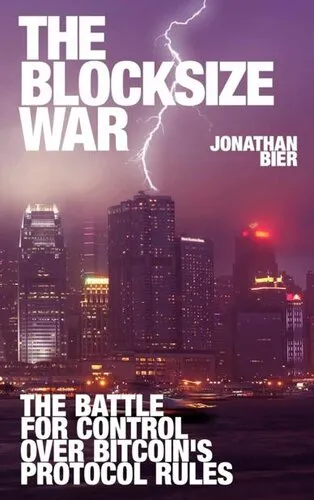The Blocksize War: The battle for control over Bitcoin’s protocol rules
4.5
Reviews from our users

You Can Ask your questions from this book's AI after Login
Each download or ask from book AI costs 2 points. To earn more free points, please visit the Points Guide Page and complete some valuable actions.Related Refrences:
Introduction to "The Blocksize War: The Battle for Control Over Bitcoin's Protocol Rules"
Bitcoin, the world's first decentralized cryptocurrency, is not just revolutionary in its design and purpose—it also sparked intense ideological debates about how it should evolve. "The Blocksize War" by Jonathan Bier chronicles one of the most critical and dramatic periods in Bitcoin's history, when disagreements over its scalability led to years of contentious debate and, ultimately, changes to the network's protocol.
The book goes beyond technical jargon and provides a fascinating narrative of how this war unfolded between developers, miners, businesses, and the broader Bitcoin community. It captures the philosophical, technical, and economic aspects of the conflict that still resonate with cryptocurrency enthusiasts and blockchain advocates today. Through this detailed exploration of Bitcoin’s blocksize debate, the book highlights how decisions affecting protocol rules are made and the decentralized power structures that underpin Bitcoin’s governance.
Detailed Summary of the Book
"The Blocksize War" dissects the dispute that lasted from 2015 to 2017, centering around one main question: Should Bitcoin’s blocksize limit be increased to allow for a higher transaction throughput? This question might seem technical, but it directly impacted Bitcoin’s performance, decentralization, and ideological guiding principles.
The book begins by explaining the roots of the conflict. Bitcoin was originally designed with a 1MB blocksize capacity, a rule added later by Bitcoin's creator, Satoshi Nakamoto, as a safeguard against spam attacks. Over time, as Bitcoin gained traction, some stakeholders argued that increasing the blocksize would resolve network congestion and lower transaction fees. However, others feared that such a change would adversely affect Bitcoin’s decentralization, making it harder for smaller participants to operate full nodes and thus endangering network security.
Jonathan Bier masterfully outlines the key actors in this debate, including core developers, mining pools, businesses, exchanges, and even vocal Bitcoin users. While some supported “big blocks,” advocating for an increase in blocksize to scale Bitcoin for mainstream adoption, others opposed this, pushing for alternative solutions such as off-chain scaling technologies like the Lightning Network.
Through in-depth analysis and a neutral perspective, Bier documents the various proposals, forks, and software implementations that emerged as part of the debate. Major events, such as the implementation of Segregated Witness (SegWit), the New York Agreement, and the contentious Bitcoin Cash fork, are carefully examined to provide readers with a full understanding of how the "blocksize war" shaped Bitcoin’s history.
By the end of the book, readers are left with an appreciation of not only the technical nuances involved in Bitcoin’s protocol but also the social dynamics and power struggles that occur in decentralized decision-making processes.
Key Takeaways
- Decentralization Matters: The blocksize debate highlighted why preserving decentralization is critical to Bitcoin’s ethos and long-term sustainability.
- Scaling Isn’t Just Technical: While increasing the blocksize might have been a simple technical solution, it had far-reaching philosophical and economic implications.
- Governance in Open Source Systems: Bitcoin’s open-source governance model allowed for robust debate but also revealed the challenges of achieving consensus in a decentralized system.
Famous Quotes from the Book
"Bitcoin was born out of a desire for financial sovereignty, but its long-term success depends on safeguarding its decentralized foundations."
"The blocksize war was never just about the size of Bitcoin blocks—it was about control, ideology, and the future of financial innovation."
"Decisions about Bitcoin’s rules are not made through governance but through consensus, and consensus is a messy, human process."
Why This Book Matters
"The Blocksize War" is not just a historical account; it’s an essential resource for anyone interested in blockchain technology, economics, or open-source governance. The book provides invaluable insights into how Bitcoin operates as a truly decentralized system where no single party can dictate its future. It underscores the importance of transparency, consensus, and compromise in navigating conflicts of interest within a distributed network.
Whether you’re a Bitcoin enthusiast, a software developer, or simply curious about the cryptocurrency space, this book equips you with the knowledge to better understand Bitcoin’s resilience and the principles that make it distinct from any other financial system or technology. The blocksize war was a watershed moment that strengthened Bitcoin’s governance and highlighted the challenges of making decisions in a trustless and leaderless ecosystem.
As the cryptocurrency world continues to evolve, debates like those chronicled in "The Blocksize War" will persist. By examining one of the most contentious moments in Bitcoin's history, the book offers a lens through which we can view the present and anticipate the future of blockchain technology.
Free Direct Download
You Can Download this book after Login
Accessing books through legal platforms and public libraries not only supports the rights of authors and publishers but also contributes to the sustainability of reading culture. Before downloading, please take a moment to consider these options.
Find this book on other platforms:
WorldCat helps you find books in libraries worldwide.
See ratings, reviews, and discussions on Goodreads.
Find and buy rare or used books on AbeBooks.
1161
بازدید4.5
امتیاز0
نظر98%
رضایتReviews:
4.5
Based on 0 users review
Questions & Answers
Ask questions about this book or help others by answering
No questions yet. Be the first to ask!





![The Ultimate iOS Interview Playbook: Conquer Swift, frameworks, design patterns, and app architecture [Team-IRA]](https://s3.refhub.ir/images/thumb/The_Ultimate_iOS_Interview_Playbook__Conquer__29925.webp)







